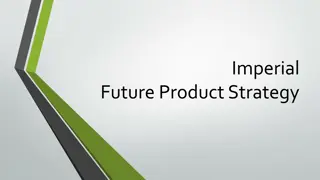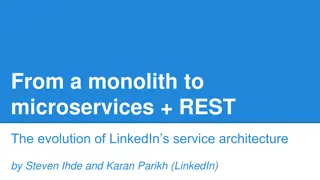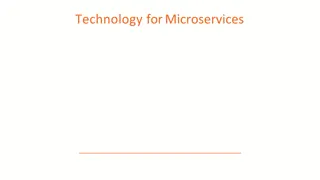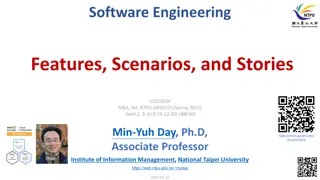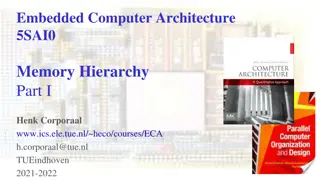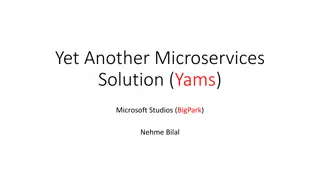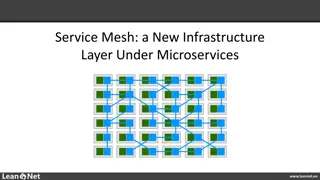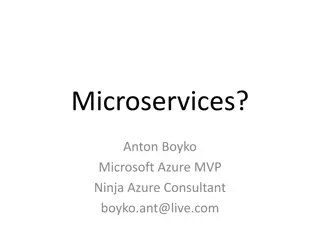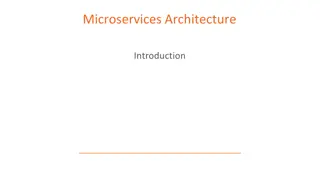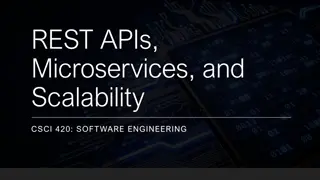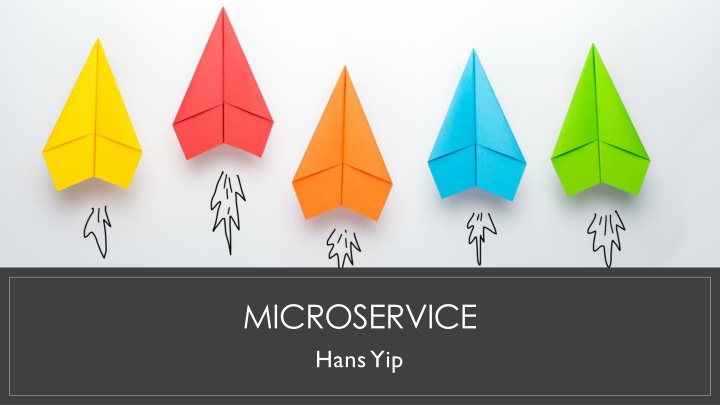
Introduction to Microservices Architecture
Microservices architecture is a modern approach to software development, breaking down applications into smaller, independent services. This architecture allows for flexibility, scalability, reusability, and easier maintenance compared to traditional monolithic applications.
Download Presentation

Please find below an Image/Link to download the presentation.
The content on the website is provided AS IS for your information and personal use only. It may not be sold, licensed, or shared on other websites without obtaining consent from the author. If you encounter any issues during the download, it is possible that the publisher has removed the file from their server.
You are allowed to download the files provided on this website for personal or commercial use, subject to the condition that they are used lawfully. All files are the property of their respective owners.
The content on the website is provided AS IS for your information and personal use only. It may not be sold, licensed, or shared on other websites without obtaining consent from the author.
E N D
Presentation Transcript
MICROSERVICE Hans Yip
Learning Objectives What is microservice? Characteristics of Microservice Microservice vs Monolithic applications Amazon AWS microservices Microsoft Azure microserivces
WHAT IS MICROSERVICE?
What is microservice? microService: is an architectural style in which applications are composed from loosely coupled API services with automated lifecycles. NOTE: Microservice is a variant of the SOA (Service- oriented architecture) architectural style that structures an application as a collection of loosely coupled services.
Without MicroService PAST Complex, single-unit, Monolithic solutions
With MicroService FUTURE Cloud & microService based, SaaS solutions
Characteristics of microService Behavior: Deployed Independently & Frequently. Control: Easily Scale Development. Reusability: Services are built for reusable. Resiliency: Independently Affected & Highly Observable (easy to id the problem). (Easy to recover)
MicroServices vs Monolithic Applications Traditional software development processes (waterfall) usually result in relatively large teams working on a single, monolithic deployment artifact. There are some issues with the traditional approaches: no single developer (or group of developers) understands the entirety of the application. Limited re-use is realized across monolithic applications. Scaling monolithic applications can be challenging.
MicroServices vs Monolithic Applications A microservice architecture with cloud deployment technologies and API management provides an alternate approach to software development. The monolith is instead broken up into a set of independent services that are deployed and maintained separately. This has the following advantages: Services are encouraged to be small. (less time to develop, and easy to deploy) Services using standard interface protocol can be consumed and re-used by other services. Services exist as independent deployment artifacts and can be scaled independently.
MicroServices vs Monolithic Applications The tradeoff of this flexibility is complexity. Managing a multitude of distributed services at scale is difficult: Services potentially are too granular . (good documentation is needed, so that easy to search for them, and easy to id the impact during services downtime. Testing may be complex). Degrading performance during heavy use of services.
Amazon AWS with Microservices Microservices: are an architectural and organizational approach to software development where software is composed of small independent services that communicate over well-defined APIs. These services are owned by small, self-contained teams. Microservices architectures make applications easier to scale and faster to develop, enabling innovation and accelerating time-to-market for new features.
Amazon AWS with Microservices Two ways to set up Microservices with Amazon AWS: Microservices with Amazon Elastic Container Service (Containers). Microservices with AWS Lamda (Serverless). For more information, please refer to: https://aws.amazon.com/microservices/
Microsoft Azure with Microservices A microservices architecture consists of a collection of small, autonomous services. Each service is self-contained and should implement a single business capability. Microsoft Azure Microservices components: Clients: are users of the microservices. Management: is responsible for placing services on nodes, identifying failures, rebalancing services across nodes, and so forth. Service Discovery: maintains a list of services and which nodes they are located on. Enables service lookup to find the endpoint for a service. API Gateway: is the entry point for clients. Clients don't call services directly. Instead, they call the API gateway, which forwards the call to the appropriate services on the back end. The API gateway might aggregate the responses from several services and return the aggregated response.
Microsoft Azure with Microservices Two ways to use Microsoft Azure with Microservices: Microservices using Azure Container Service. Microservices using Azure Service Fabric. For more information, please refer to: https://docs.microsoft.com/en- us/azure/architecture/guide/architecture- styles/microservices
References http://searchmicroservices.techtarget.com/definition/microservices http://searchmicroservices.techtarget.com/definition/service-oriented-architecture-SOA https://martinfowler.com/articles/microservices.html https://www.mulesoft.com/








